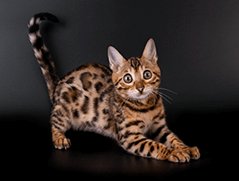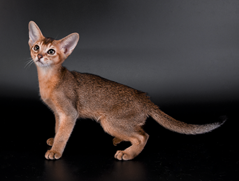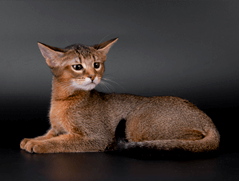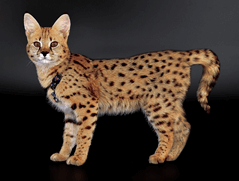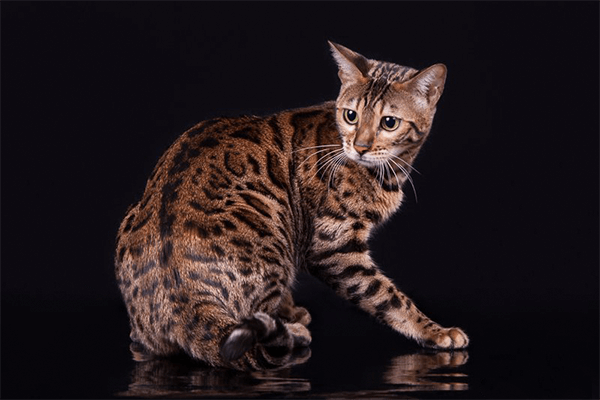 Bengals are a combination of wild appearance and pristine grace with a loving, devoted and truly “doggy” character.
Bengals are a combination of wild appearance and pristine grace with a loving, devoted and truly “doggy” character.
As a rule, Bengal cats do not differ in size from outbred pets, but their wild ancestor left an indelible mark on their appearance. It is not for nothing that Bengal cats are called “domestic leopards” or “mini leopards”, and their outdated name is “leopardette”. Bengal cats have longer legs than normal cats, while the hind legs are longer than the front ones, from which the tail of the body is slightly raised. Paws are large and round. The strong, muscular, toned body of the Bengals resembles that of a leopard. Adult Bengal cats are much larger than cats, their weight can reach 12 – 13 lb, and the body length (including the length of the tail) is up to 38 in. The average weight of an adult Bengal female is 9 – 11 lb, the length of the body with a tail is from 33 in. The Females are graceful, male – strong, athletic build. The tail of the Bengal is of medium length, wide at the base, thick, dense, tapering towards the tip.
The head of the Bengal, in comparison with the body, is not large, the muzzle is slightly elongated, its length exceeds the width, narrowed and rounded at the nose. The cheekbones are pronounced, the pads are round, the nose is wide, the eyes are large, expressive, set wide apart. The ears of a Bengal cat are of medium size, without tassels. Ears that are too developed are considered a deviation from the breed standard.
The coat of Bengal cats does not require special care, does not contain undercoat, so it will not lie in tangles around the apartment. Coat is short, dense, soft, silky, very pleasant to the touch, smooth, with a mirror effect of light reflection, which experts call the “glitter effect”.
Bengal cats are a hybrid breed. The progenitor of Bengal is a wild Asian leopard cat. So how are Bengals made? The first generation of kittens born when crossing an ordinary Bengal cat with a wild Asian leopard cat is designated F1. These kittens have 50% of the blood of an Asian leopard cat. The second generation of Bengal kittens is born by crossing an F1 Bengal female and a domestic cat (SBT Bengal male) and is designated F2. Such kittens will already have 25% of the blood of the Asian Leopard Cat (ALC). To obtain offspring Bengal F3, it is necessary to cross a female Bengal F2 with a male Bengal SBT. With further crossing of the F3 hybrid female with the SBT Bengal male, kittens of the 4th generation (designated F4) will be born and further up to the fifth generation – F5. The lower the numeric value around F, the more the kitten should look like an Asian leopard cat. The first two generations – F1 and F2 – are almost identical in appearance to their wild ancestor, and females are promising for breeding. Males up to the 4th generation cannot have offspring, they are sterile.
SBT (Stud Book Traditional) is a Bengal cat, whose parents, as well as grandparents, great-grandparents and great-grandparents are Bengal. The SBT is considered a “pure” Bengal breed.
The first three generations, from the initial mating of an Asian leopard cat with a domestic cat to the birth of the fourth generation, are considered “basic” and are designated as F1, F2, F3. All these three generations (F1, F2, F3) belong to the early generations (EG).
The letter F means “filius”, which is translated from Latin as “son” and in this case means “descendant”. Although breeders believe that F1, F2 and F3 Bengal cats are safe and suitable for domestic use, these cats are not allowed to participate in shows. They are considered the foundation on which a “healthy” purebred Bengali line is built, free from human “mistakes”.
One of the Benaby cattery’s programs is the breeding of the first generations of Bengal cats, Early Generation Bengals, or EG’s . In our cattery you can buy Bengal kittens of F1, F2 and F3 generations, and, of course, SBT kittens. Many people believe that first-generation hybrids remain wild. It is not true. A hybrid cat is no longer a wild animal and its main difference from a wild Asian leopard cat is the ability to calmly interact with people and live with them.

